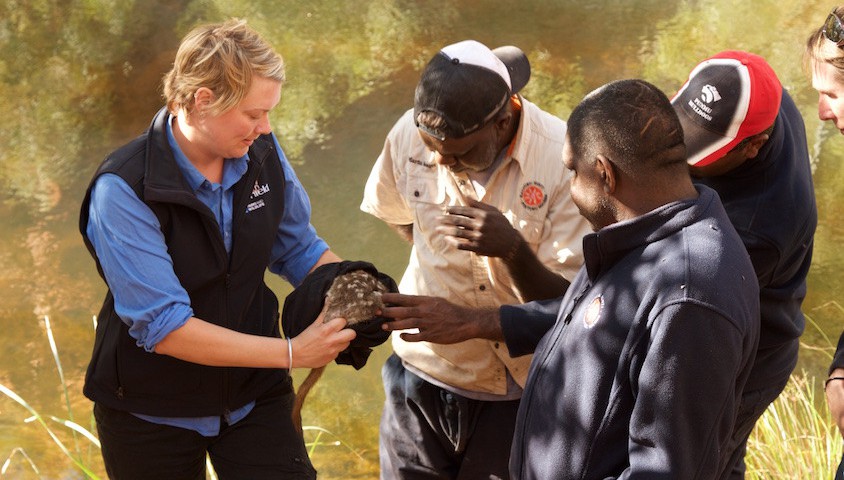In an effort that’s being hailed an exemplar in conservation partnerships between government and traditional owners, a northern quoll has been captured in Karlamilyi National Park, Western Australia.
While the species have been recorded elsewhere in the state, there has been no scientific record of the species as far east as Karlamilyi, despite traditional owners having knowledge of them up to the 1960s.
The northern quoll (Dasyurus hallucatus) is listed as endangered by the IUCN, and endangered in WA, with primary threats being cane toads (not yet present in the Pilbara), feral predators especially feral cats and foxes, and habitat degradation due to inappropriate fire regimes, mining, and overgrazing.
Called wiminyji in the local language, the northern quoll was familiar to Martu people until their traditional way of life was disrupted.
More recently, Kanyirninpa Jukurrpa (KJ) Punmu and Parnngurr rangers and scientists from the Department of Parks and Wildlife (DPAW) have been motivated to capture a live quoll following an individual being caught on camera trap footage in 2012.
“We successfully captured a quoll on our second trapping survey,” said Gareth Catt, who is a fire management officer for KJ. “It’s pretty exciting because it was the first time the local people had seen a northern quoll since leaving their traditional lifestyle.”
“This live capture not only extends the species’ known range, but it also gives us clues as to where else the quolls may be and how we can work towards achieving their beneficial management.”
DPAW research scientist, Dr Judy Dunlop assisted in the quoll survey and believes the presence of the quoll is an unusual one.
“Quoll distribution prior to 2012 went as far east as Nullagine in the Pilbara, but this capture extends their known range by 200 kilometres. The area it was discovered in is essentially a rocky area suitable for quoll habitation, surrounded by desert. There’s no continuous rocky habitat between this population and any other,” Dunlop said.
As a result, Dunlop is now looking forward to run genetic tests in order to ascertain whether the Karlamilyi quolls are more closely to others in the Pilbara, or the populations spanning the Kimberley, Northern Territory and Queensland.
For Catt, the project has highlighted the positive benefits that partnerships between government organisations and traditional owners can offer, particularly in conservation.
“This project was a genuine partnership between the Martu, KJ and DPAW,” Catt said. “There was learning in both directions. Not only is there a lot to be gained from traditional knowledge, but it becomes even more powerful when combined with contemporary methods.”
KJ Martu rangers are funded by the Australian government’s Working on Country program, as well as through the Martu Living Deserts Project (a collaboration between The Nature Conservancy, BHP and KJ). As a result, KJ itself is an example of multi-stakeholder partnerships involving Martu and non-Martu people in WA, seeking to incorporate traditional knowledge within contemporary practices



